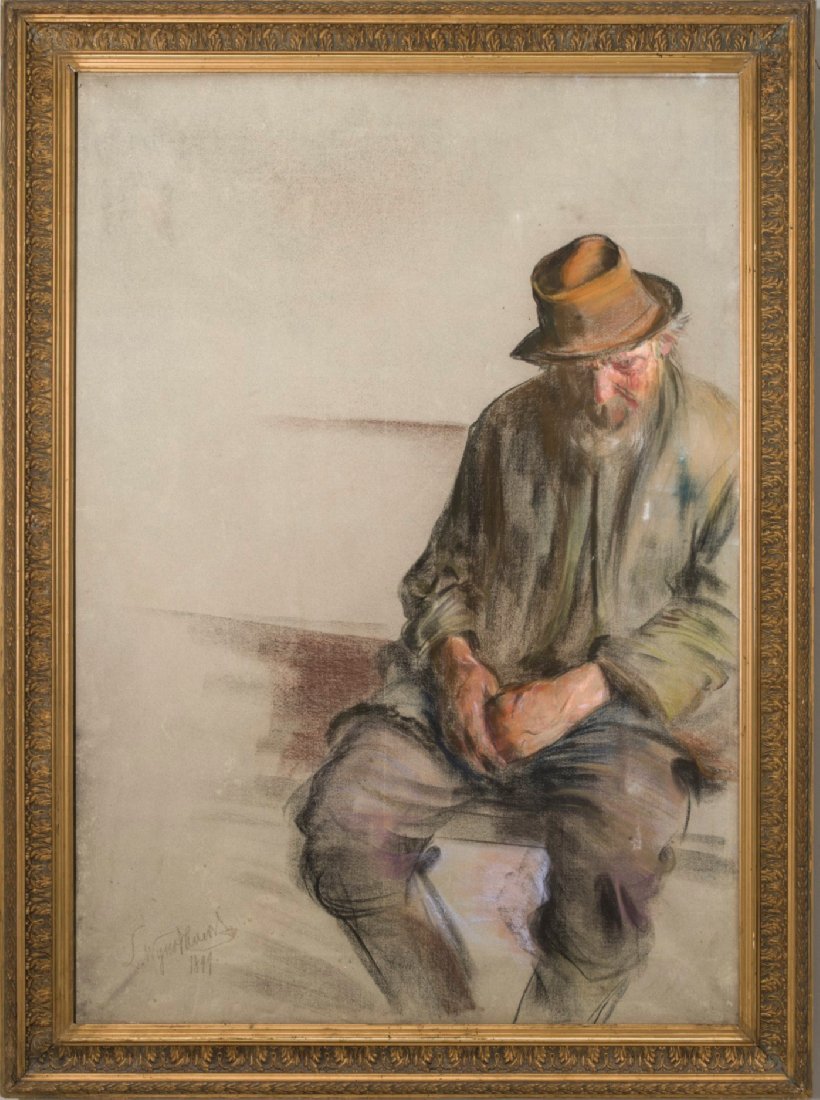Description:
Leon Wyczółkowski (1852-1936) had been visiting Ukraine since the 1880s. He stayed in Berezna with Kazimierz Podhorski, his brother Michał and his sons – Władysław and Stefan*. Later he recalled, “I left at night and until morning I couldn’t get enough. I couldn’t be indifferent to the beauty of nature. The most beautiful country. […] Groves of bee hives […] dozens of beehives […] the river flowing, delightful spring, mass of reeds with osier, fishermen busy, blooming trees, the sky like in the South, dark blue, ultramarine, and against this backdrop, flowers. Colorful people, bukszpans, ribbons, wonderful images like from a fairy tale. No wonder that then I couldn’t get used to something else.”**.
Description of the painting:
“That his art is so close to the earth and heart is only due to the kind of his talent. Wyczółkowski-the man added nothing and took nothing from it. No slogans ever entered it, no ideas. It was only acted upon by the image of the world and much less, the image reflected in someone else’s creativity. Wyczółkowski never tried to reason with it, illuminate it, bend it, direct it. He was full of zeal, diligent and devoted servant. To give the purely artistic content in the closest form to it and the best technique is the only goal of Wyczóła.”*
Upon returning from Ukraine in 1895, at the invitation of the then rector of the Kraków Art Academy – Julian Fałat, Leon Wyczółkowski moved to the city of poets. He headed the painting studio at the School of Fine Arts. The artistic life of Krakow fully enchanted him. He was one of the founding members of the Polish Artists’ Society “Sztuka”. In 1898 he became the artistic director of the magazine “Życie”, and in 1899 – an extraordinary professor of the Krakow School of Fine Arts. Towards the end of the 1890s, under the influence of artistic inspiration by Julian Fałat and Feliks Jasieński and the growing fascination with Japanese art and that of the modernism period, Leon Wyczółkowski’s artistic activity began a time of creative experiments. “Immortality of enthusiasm! That’s where the secret of the always youthful creative force of this genius artist lies. There is a fire in his soul that demands its complete burning on the altar of art, yet it resurrects the creative spirit to new efforts and ascents, it gladdens him to the whiteness of inspiration and forces him to artistic expression obediently – and the body obediently follows its impulses. That’s how you get “Starec” – the secret of life but life in spirit! “***.
In 1899, “The Old Man’s Studio” was created. Wyczółkowski painted it at the age of 47. Three horizontal lines outline the shape resembling a dark brown wooden bench. Asymmetrically, on the right side of the pictorial field, the artist placed the sitting, slightly slanted figure of the titular “Grandfather”. Famous for his speed in drawing, the artist focuses mainly on the wrinkled face and hands of the elderly man. Tired, the old man perched on the edge of the bench. He is not posing. He doesn’t even look up at the artist. His eyes are slightly closed and look into the empty space around him. The head of the figure is framed by the remains of gray hair, while the contour of the face is delicately blurred by a silver beard. The worn hands with slightly deformed fingers are joined and rest easily on the body of the portrayed. The man’s costume, faded and worn in dark colors, and the brown hat on his head emphasize his social status.
The compositional device used stands out, with the entire weight of the painting being shifted to the right side, thus intensifying the decadent feeling of exclusion and isolation of the portrayed individual. The encompassing emptiness of know a specific person, but a study of the embodiment of loneliness, as presented by Leon Wyczółkowski, linked to the end of human life.
“What then is left us, what do we all know,
For which no ancient creed will still suffice?
What is thy shield against the evil spear
Of man in this late age?…The head bowed mutely.”
(Kazimierz Przerwa-Tetmajer, “End of the Age”)


